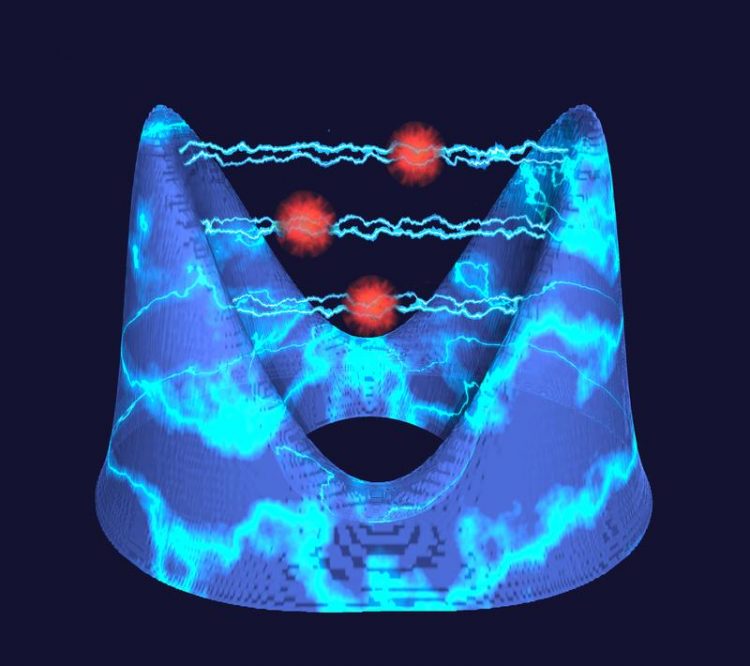A Quantum of Light for Materials Science

The charge density of an electron (in blue) changes its form due to the interaction with photons (in red). Picture: © J.M. Harms/MPSD
Scientists of the Max-Planck Institute for the Structure and Dynamics of Matter at CFEL in Hamburg and the Fritz Haber Institute of the Max Planck Society in Berlin have now shown how the effects of the photons can be properly included in such calculations.
This study opens up the possibility to predict and control the change of material properties due to the interaction with light particles from first principles. The study is reported today in Proceedings of the National Academy of Sciences.
The basic building blocks of atoms, molecules and solids are positively charged nuclei and negatively charged electrons. Their mutual interactions determine most physical and chemical properties of matter, such as the electrical conductivity or the absorption of light.
The laws that guide this delicate interplay between electrons and nuclei are those of quantum electrodynamics (QED), in which particles interact via the exchange of photons, which are the quanta of light. However, the equations of QED are so complex that in practice scientists have to simplify them to be able to make any prediction for real materials.
A very common simplification in quantum chemistry and solid-state physics is to neglect the quantum nature of light. Although this assumption works well for many applications, recent experiments have uncovered situations where the quantum nature of the photons can dramatically change the material properties and give rise to new collective behavior and phenomena.
The standard simulation techniques usually neglect the photons. In order to simulate such situations on a computer, the theory department of the MPSD, headed by Prof. Angel Rubio, has thus developed a novel theoretical method that also includes the interaction with photons.
The basic idea is to treat the full QED system of particles and photons as a quantum fluid. Here the particles are represented by a charge current, and the photons by a classical electromagnetic field that acts on the current in a very complex manner. In their current work, the researchers have shown how this approach can exactly describe the dynamics of an electron that is trapped on a surface and that strongly interacts with photons.
“The advantage of this reformulation of the coupled electron-photon problem is that it allows for approximations that treat photons and particles on equal footing.,” says Johannes Flick, one of the lead authors of the work, “In this way we can come up with new simulation techniques that do not neglect the photons while still being simple enough to be practical,” adds Michael Ruggenthaler, second lead author of the article.
In a next step after this proof-of-principle, Rubio’s team wants to use the developed technique to investigate complex systems in situations where photons are assumed to play an important role and hence learn how this modifies the properties of materials. This could provide a new way to control and alter chemical reactions in complex systems such as biomolecules and to design new states of matter.
Contact person:
Dr. Michael Ruggenthaler
Max Planck Institute for the Structure and Dynamics of Matter
Center for Free-Electron Laser Science
Luruper Chaussee 149
22761 Hamburg
Germany
+49 (0)40 8998-6554
michael.ruggenthaler@mpsd.mpg.de
Original publication:
J. Flick, M. Ruggenthaler, H. Appel, and A. Rubio, “Kohn–Sham approach to quantum electrodynamical density-functional theory: Exact time-dependent effective potentials in real space,” Proceedings of the National Academy of Sciences (2015), DOI: 10.1073/pnas.1518224112
http://dx.doi.org/10.1073/pnas.1518224112 Original publication
http://www.mpsd.mpg.de/113438/theod Research group of Prof. Dr. Angel Rubio
http://www.mpsd.mpg.de/en Max Planck Institute for the Structure and Dynamics of Matter
Media Contact
All latest news from the category: Physics and Astronomy
This area deals with the fundamental laws and building blocks of nature and how they interact, the properties and the behavior of matter, and research into space and time and their structures.
innovations-report provides in-depth reports and articles on subjects such as astrophysics, laser technologies, nuclear, quantum, particle and solid-state physics, nanotechnologies, planetary research and findings (Mars, Venus) and developments related to the Hubble Telescope.
Newest articles

Superradiant atoms could push the boundaries of how precisely time can be measured
Superradiant atoms can help us measure time more precisely than ever. In a new study, researchers from the University of Copenhagen present a new method for measuring the time interval,…

Ion thermoelectric conversion devices for near room temperature
The electrode sheet of the thermoelectric device consists of ionic hydrogel, which is sandwiched between the electrodes to form, and the Prussian blue on the electrode undergoes a redox reaction…

Zap Energy achieves 37-million-degree temperatures in a compact device
New publication reports record electron temperatures for a small-scale, sheared-flow-stabilized Z-pinch fusion device. In the nine decades since humans first produced fusion reactions, only a few fusion technologies have demonstrated…





















